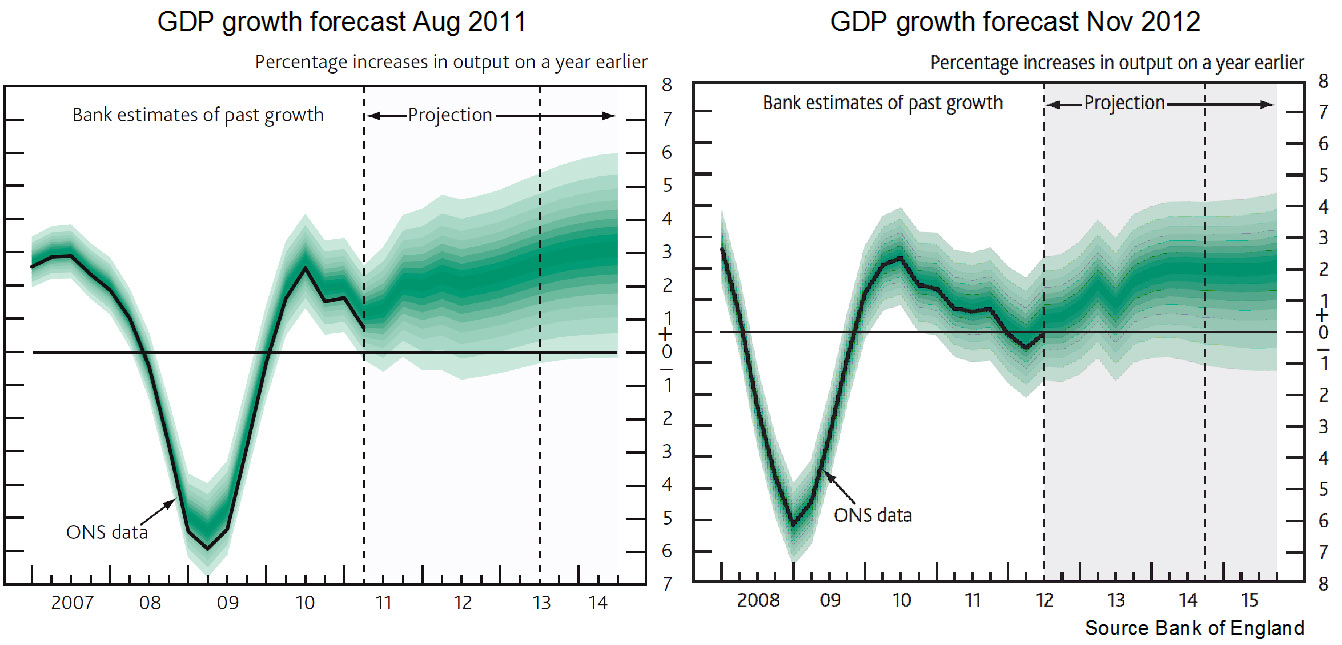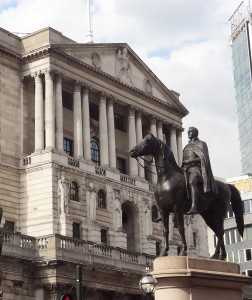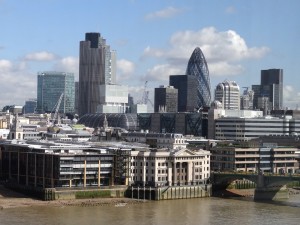 In a previous blog, Anyone got a crystal ball?, we reported on the Bank of England’s and other agencies’ difficulty in making forecasts. As the Governor, Mervyn King, said, “There is just enormous uncertainty out there.”
In a previous blog, Anyone got a crystal ball?, we reported on the Bank of England’s and other agencies’ difficulty in making forecasts. As the Governor, Mervyn King, said, “There is just enormous uncertainty out there.”
The Bank of England has just published its November Inflation Report. This quarterly publication gives forecasts of inflation, GDP and other indicators. It is clear that forecasting hasn’t become any easier. In his opening remarks, Dr. King says:
Continuing the recent zig-zag pattern, output growth is likely to fall back sharply in Q4 as the boost from the Olympics in the summer is reversed – indeed output may shrink a little this quarter. It is difficult to discern the underlying picture. It is probably neither as good as the zigs suggest nor as bad as the zags imply.

The Inflation Report looks at the various factors affecting aggregate demand, inflation, unemployment and aggregate supply. It is quite clear on reading the report why there is so much uncertainty.

A salutary lesson is to look back at previous forecasts and see just how wrong they have been. The chart above shows the forecasts for GDP made in the Inflation Reports of Nov 2012 and Aug 2011. You can see that they are significantly different and yet just 15 months apart. You might also like to compare the forecasts made a year ago (or even two!) about 2012 with the actual situation today. A good source for this is the Treasury’s Forecasts for the UK economy. This collates the forecasts from a range of independent forecasters.
The inaccuracy of forecasting is an inevitable consequence of a highly interdependent world economy that is subject to a range of economic shocks and where confidence (or lack of it) is a major determinant of aggregate demand. But when firms, governments, individuals and central banks have to make plans, it is still necessary to project into the future and try to forecast as accurately as possible – even though it might mean keeping your fingers firmly crossed.
Articles
Bank of England downgrades growth forecast for 2013 Daily Record (14/11/12)
A gloomy picture from the Old Lady Financial Times (14/11/12)
Will Britain’s post-recession economy be resurgent, stagnant or greener? The Guardian, Larry Elliott (11/11/12)
Economics must heed political risk Financial Times, Sebastian Mallaby (6/11/12)
European Commission autumn forecast: overoptimistic and in denial Social Europe Journal, Andrew Watt (7/11/12)
Bank of England gets long to-do list for overhaul Reuters, Sven Egenter (2/11/12)
Data
Inflation Report, November 2012 Bank of England
Index of economic forecasts European Commission DGECFIN
Economic Outlook Annex Tables OECD
World Economic Outlook Reports IMF
Forecasts for the UK economy HM Treasury
Questions
- What was being forecast for economic growth and inflation for 2012 (a) one year ago; (b) two years ago?
- What are the main reasons for the inaccuracy of forecasts?
- How might forecasting be made more reliable?
- If sentiment is a key determinant of economic activity, how might politicians increase the confidence of firms and consumers? What are the political constraints on doing this?
- Explain the following statement from the Guardian article: “The problem … is that last decade’s tailwind has become this decade’s headwind.” Why is it difficult to forecast the strength of this ‘headwind’?
- How useful is it to use past trends as a guide to the future course of the economy?
 This has been a week of gloomy prognostications. On Wednesday 16 May, the Bank of England published its quarterly Inflation Report – and it makes worrying reading.
This has been a week of gloomy prognostications. On Wednesday 16 May, the Bank of England published its quarterly Inflation Report – and it makes worrying reading.
The forecast of UK economic growth for 2012 has been reduced from 1.2% in the previous report to 0.8%. But the rate of inflation is forecast to remain above the 2% target well into next year. However, at the two-year horizon, inflation is now forecast to be 1.6% – below the target, thus giving the MPC scope for further quantitative easing.
In the introduction to the report, the Governor, Mervyn King, writes:
Over the past year or so, two factors have hampered the recovery and rebalancing by more than expected. First, higher-than-expected world commodity and energy prices have squeezed real take-home pay, dampening consumption growth. Second, credit conditions, far from easing, have in some cases become tighter. The direct and indirect exposures of UK banks to the euro-area periphery have affected funding costs as the challenges of tackling the indebtedness and lack of competitiveness in those countries have intensified.
And at the news conference launching the report, he said:
We have been through a big global financial crisis, the biggest downturn in world output since the 1930s, the biggest banking crisis in this country’s history, the biggest fiscal deficit in our peace time history and our biggest trading partner – the euro area – is tearing itself apart without any obvious solution.
The idea that we could reasonably hope to sail serenely through this with growth close to the long run average and inflation at 2% strikes me as wholly unrealistic. We’re bound to be buffeted by this and affected by it.
 The following articles look at the Bank of England’s predictions and at the challenges facing the UK economy as the crisis in the eurozone deepens and as inflation in the UK remains stubbornly above target. They also look at the issue of the extent to which capacity has been lost as a result of the continuing weakness of the UK economy. As The Economist article states:
The following articles look at the Bank of England’s predictions and at the challenges facing the UK economy as the crisis in the eurozone deepens and as inflation in the UK remains stubbornly above target. They also look at the issue of the extent to which capacity has been lost as a result of the continuing weakness of the UK economy. As The Economist article states:
Business surveys suggest only a small proportion of firms are operating below capacity. That finding looks odd given the economy’s output is still 4% below its level at the start of 2008, and is much farther below the level it would have reached if GDP growth had continued at its long-term rate. The picture painted by surveys could be right if a chunk of the economy’s potential has been written off for good. But Sir Mervyn King, the bank’s governor, doubts this. There is “no obvious reason” why the economy could not rejoin its pre-crisis path, though it might take a decade or two to get there, he said on May 16th.
We look in more detail at the question of lost capacity in Part 2.
Articles
 Bank of England cuts growth forecasts: Sir Mervyn King’s speech in full The Telegraph (16/5/12)
Bank of England cuts growth forecasts: Sir Mervyn King’s speech in full The Telegraph (16/5/12)
Bank of England sees inflation up and growth falling Independent, Ben Chu (17/5/12)
Hard going The Economist (19/5/12)
Bank of England optimism dented again Financial Times, Chris Giles (16/5/12)
Eurozone is ‘tearing itself apart’, says Mervyn King. True, but the UK’s problems are as intractable as ever The Telegraph, Philip Aldrick (16/5/12)
Inflation Report
Inflation Report: portal page Bank of England
Inflation Report: May 2012 Bank of England (16/5/12)
Additional Data
Statistical annex to European Economy. Spring 2012 European Commission, Economic and Financial AffairsAnnual macro-economic database European Commission, Economic and Financial Affairs (11/5/12) (see particularly section 6.5)
Forecasts for the UK economy HM Treasury
Questions
- What explanations are given for the rate of CPI inflation remaining persistently above the 2% target?
- Why have the prospects for economic growth worsened since the publication of the February Inflation Report?
- How might it be possible to have a narrowing (negative) output gap and yet a stagnant economy?
- Why may capacity have been lost since the financial crisis of 2008?
- Why has M4 declined despite the programme of quantitative easing? (See M4 in record fall despite QE.)
- What scope is there for monetary policy in achieving faster economic growth without pushing inflation above the 2% target?
Every quarter, the Bank of England publishes its Inflation Report. This analyses developments in the macroeconomy and gives forecasts for inflation and GDP growth over the following 12 quarters. It is on the forecast for inflation in 8 quarters’ time that the Bank of England’s Monetary Policy Committee primarily bases its interest rate decision.
According to the February 2011 Inflation Report forecast, CPI inflation is expected to be at or slightly below its 2% target in two year’s time, but there is considerable uncertainty about this, as shown in the fan diagram in Chart 3 of the Overview. What is more, inflation is likely to rise considerably before it falls back. As the Report states:
CPI inflation is likely to pick up to between 4% and 5% in the near term and to remain well above the 2% target over the next year or so, reflecting in part the recent increase in VAT. The near-term profile is markedly higher than in November, largely reflecting further rises in commodity and import prices since then. Further ahead, inflation is likely to fall back, as those effects diminish and downward pressure from spare capacity persists. But both the timing and extent of that decline in inflation are uncertain.
It is interesting to look back at the Inflation Reports of a year ago and two years ago to see what was being forecast then and to compare them with what has actually happened. It’s not too difficult to explain why the forecasts have turned out to be wrong. Hindsight is a wonderful thing. Unfortunately, foresight is less wonderful.
Articles
BoE forecasts pave way to rate rise, but King cautious Reuters, Matt Falloon and Fiona Shaikh (16/2/11)
Inflation report: what the economists say Guardian (16/2/11)
Inflation will rise sharply, says Mervyn King BBC News (16/2/11)
The unrepentant governor BBC News blogs: Stephanomics, Stephanie Flanders (16/2/11)
Inflation: Mervyn and me BBC News blogs: Idle Scrawl, Paul Mason (16/2/11)
What would Milton do? The Economist, Buttonwood (16/2/11)
Why inflation hawks are still grounded Fortune, Colin Barr (16/2/11)
Podcast and Webcast
 Bank of England Press conference: Podcast (16/2/11)
Bank of England Press conference: Podcast (16/2/11)
 Bank of England Press conference: Webcast (16/2/11)
Bank of England Press conference: Webcast (16/2/11)
Inflation Report
Inflation Report, portal page for latest report and sections, Bank of England
Inflation Report, February 2011: full report, Bank of England
Data
Forecasts for the UK economy: a comparison of independent forecasts, HM Treasury
Prospects for the UK economy, National Institute of Economic and Social Research press release (1/2/11)
Output, Prices and Jobs, The Economist (10/2/11)
Questions
- Examine the forecasts for UK inflation and GDP for 2010 made in the February 2009 and February 2010 Bank of England Inflation Reports. How accurate were they?
- Explain the difference between the forecasts and the outturn.
- Why is it particularly difficult to forecast inflation and GDP growth at the present time for two years hence?
- What are the advantages of the Bank of England using a forward-looking rule as opposed to basing interest rate decisions solely on current circumstances?
- Explain whether or not it is desirable for interest rates to be adjusted in response to external shocks, such as commodity price increases?
- What do you understand by the term ‘core’ inflation? Is this the same thing as demand-pull inflation?
- How is the Bank of England’s policy on interest rates likely to affect expectations? What expectations are particularly important here?
- Explain whether or not it is desirable for interest rates to be adjusted in response to external shocks, such as commodity price increases?
Letter writing has, in many walks of life, rather gone out of fashion. For instance, many of us of a slightly older disposition remember how putting pen to paper was an important part of courtship and the building of relationships. Well, one modern-day couple who are getting very used to an exchange of letters is the Governor of the Bank of England and the Chancellor of the Exchequer. The latest inflation numbers from the Office for National Statistics show that the annual rate of CPI inflation for July was 3.1%. While the inflation rate is down from the 3.2% recorded in June it remains more than 1 percentage point above the government’s central inflation rate target of 2%. Consequently, Mervyn King will again be writing to the Chancellor to explain why this is the case.
Since the turn of the year, the annual rate of CPI inflation has, with the exception of February, been consistently above 3%. Even February was a narrow escape for the Governor because inflation came in at exactly 3%! Another way of putting the recent inflation record into perspective is to note that over the first seven months of 2010 the average annual rate of CPI inflation has been 3.3%.
The slight fall in July’s annual inflation rate is attributed, in part, to falls during July in the prices of second-hand cars and petrol whereas these prices were rising a year ago. Furthermore, the average price of clothing and footwear fell by some 4.9% between June and July of this year as compared with a fall of 3.2% in the same period a year ago. The result is that the annual rate of price deflation for clothing and footwear went from 1.4% in June to 3.1% in July.
Of course, within the basket of consumer goods price patterns can vary significantly. One significant upward pressure on July’s overall annual inflation rate was the price of food and non-alcoholic beverages, especially vegetables. The average price of food and non-alcoholic beverages rose by 1% between June and July which has seen the annual rate of price inflation for food and non-alcoholic beverages rise from 1.9% in June to 3.4% in July.
The fact that July shows inflation running in excess of 3% will surprise very few. In the latest Inflation Report the Bank of England reports that the Monetary Policy Committee’s view is that ‘the forthcoming increase in VAT was expected to keep CPI inflation above the 2% target until the end of 2011’. The Committee then expects what it describes as a ‘persistent margin of spare capacity’ to force inflation to fall back. But, the Committee also feels that the prospects for inflation are ‘highly uncertain’. Therefore, it is difficult to gauge just how many more letters will be passing across London between the Governor and the Chancellor in the coming months. Nonetheless, it would be probably be advisable for the Governor to make sure that he has a sufficient supply of postage stamps at his disposal, just in case!
Articles
UK inflation rate slows again in July BBC News (17/8/10)
Bank of England’s King forced to write another letter to Osborne as prices stay high Telegraph (17/8/10)
Inflation falls to 3.1% in July Financial Times, Daniel Pimlott (17/8/10)
Dearer food keeps inflation high UK Press Association (17/8/10)
Bank ‘surprised’ at inflation strength Independent, Russell Lynch (17/8/10)
Letters
Letter from the Governor to the Chancellor and the Chancellor’s reply Bank of England (17/8/10)
Data
Latest on inflation Office for National Statistics (17/8/10)
Consumer Price Indices, Statistical Bulletin, July 2010 Office for National Statistics (17/8/10)
Consumer Price Indices, Time Series Data Office for National Statistics
For CPI (Harmonised Index of Consumer Prices) data for EU countries, see:
HICP European Central Bank
Questions
- What does the Bank of England mean by a ‘persistent margin of spare capacity’? By what economic term is this phenomenon more commonly known?
- Why do you think the current rate of inflation is above target despite the spare capacity in the economy?
- Since the annual rate of CPI inflation remains in ‘letter-writing territory’ would you expect the Monetary Policy Committee to be raising interest rates some time soon? Explain your answer.
- What impact might the persistence of above-target inflation have for the public’s expectations of inflation?
- What impact can we expect the increase in the standard rate of VAT next January to have on the annual rate of CPI inflation? Is such an effect on the rate of inflation a permanent one?
 In a previous blog, Anyone got a crystal ball?, we reported on the Bank of England’s and other agencies’ difficulty in making forecasts. As the Governor, Mervyn King, said, “There is just enormous uncertainty out there.”
In a previous blog, Anyone got a crystal ball?, we reported on the Bank of England’s and other agencies’ difficulty in making forecasts. As the Governor, Mervyn King, said, “There is just enormous uncertainty out there.”



